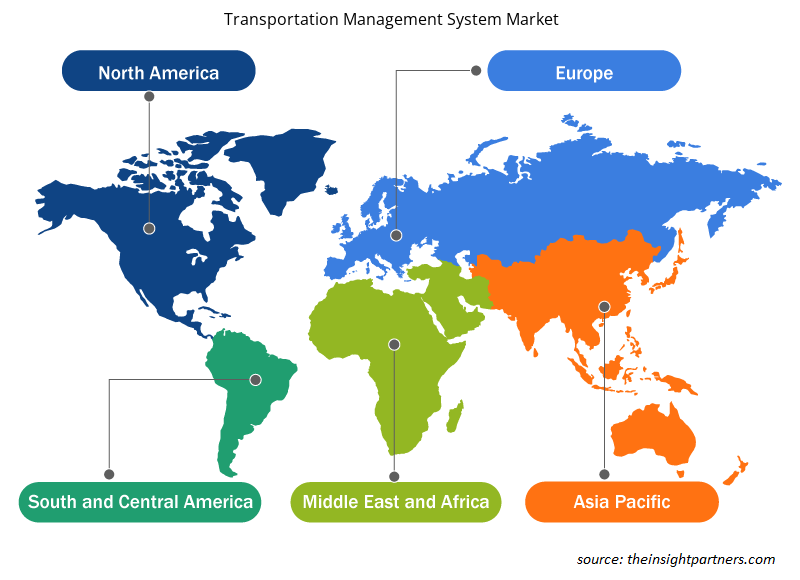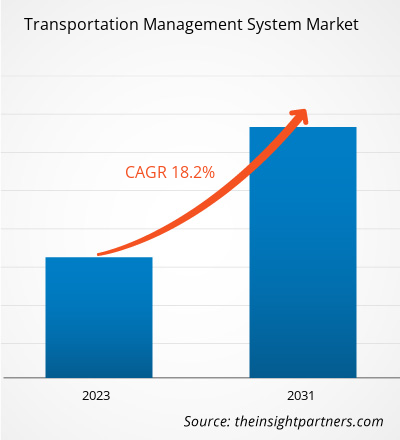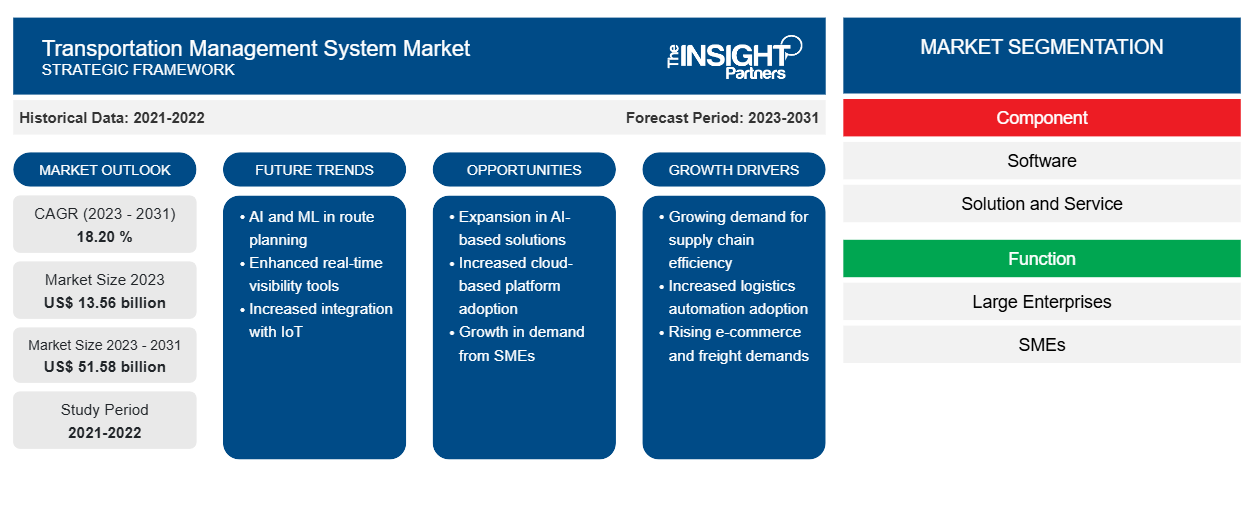Das Marktvolumen für Transportmanagementsysteme soll von 13,56 Milliarden US-Dollar im Jahr 2023 auf 51,58 Milliarden US-Dollar im Jahr 2031 anwachsen. Von 2023 bis 2031 wird für den Markt eine durchschnittliche jährliche Wachstumsrate (CAGR) von 18,20 % erwartet.
Dieser Ansatz senkt die Kosten, steigert die Versandeffizienz und verbessert den Kundenservice. Er verbindet Auftragsabwicklung und Lieferung innerhalb eines Unternehmens und ist nützlich, um ein Netzwerk guter Kundendienste aufzubauen und gleichzeitig durch die Implementierung eines Cloud-basierten Transportsystems Kosten zu senken.
Marktanalyse für Transportmanagementsysteme
Transportmanagementsysteme spielen in Lieferketten eine entscheidende Rolle und beeinflussen viele Bereiche des Prozesses, darunter Betriebsplanung, Beschaffung, Logistik und Lebenszyklusmanagement. TMS bietet umfassende Transparenz und ermöglicht so eine effektivere Transportplanung und -überwachung, was zu einer besseren Kundenerfahrung führt. Darüber hinaus machen es die sich schnell entwickelnde globale Handelsumgebung und die Transite für Unternehmen unerlässlich, über ein TMS-System zu verfügen, das ihnen dabei hilft, komplizierte Transitvorgänge und -prozesse, die Handelsregeln und -konformität beinhalten, effektiv zu bewältigen.
Marktübersicht für Transportmanagementsysteme
Der globale Markt für Transportmanagementsysteme (TMS) wird durch das Wachstum der Einzelhandels- und E-Commerce -Branchen, stetige technologische Fortschritte, die zur Einführung innovativer Lösungen auf dem Markt geführt haben, und die Stärkung der bilateralen Handelsbeziehungen zwischen verschiedenen Ländern weltweit vorangetrieben. TMS-Technologien helfen auch dabei, manuelle Lieferkettenfunktionen wie Planung und Ausführung, Routenoptimierung und Sendungsverfolgung zu automatisieren. Dadurch werden manuelle Fehler reduziert, Zeit gespart und die mit der Verwaltung von Transportvorgängen verbundenen Kosten gesenkt, was wichtige Faktoren für das Marktwachstum sind.
Passen Sie diesen Bericht Ihren Anforderungen an
Sie erhalten kostenlos individuelle Anpassungen an jedem Bericht, einschließlich Teilen dieses Berichts oder einer Analyse auf Länderebene, eines Excel-Datenpakets sowie tolle Angebote und Rabatte für Start-ups und Universitäten.
-
Holen Sie sich die wichtigsten Markttrends aus diesem Bericht.Dieses KOSTENLOSE Beispiel umfasst eine Datenanalyse von Markttrends bis hin zu Schätzungen und Prognosen.
Markttreiber und Chancen für Transportmanagementsysteme
Cloudbasierte SaaS-Lösungen werden der Transportmanagementsystembranche Auftrieb geben und den Markt begünstigen
Große Unternehmen verfügen in der Regel über eine IT-Abteilung zur Verwaltung ihrer Geschäftsprozesse, Startups und KMUs fehlt ein solches System jedoch manchmal. Die Verwaltung einer IT-Abteilung verursacht zusätzliche Kosten. Cloudbasierte Transportmanagementsysteme sind bei KMUs und Startups beliebt, da sie die Vorteile einer IT-Abteilung bieten, ohne dass zusätzliche Mitarbeiter eingestellt werden müssen oder zusätzliche Kosten entstehen. So können sich interne Mitarbeiter auf den laufenden Geschäftsbetrieb konzentrieren. Die Speicherflexibilität des cloudbasierten Transportmanagementsystems ermöglicht Erweiterungen und ist daher ideal für KMUs, um unerwartetes Wachstum zu bewältigen. Das cloudbasierte Transportmanagementsystem bietet Kostensenkungen und eine Pay-as-you-go-Strategie, sodass KMUs effektiv im Wettbewerb bestehen können. Dazu gehört auch die Echtzeitzahlung über die Cloud.
Entwicklung von 5G zur Veränderung von Verkehrsmanagementsystemen
Die Einführung der 5G-Technologie eröffnet dem Transportmanagementsystem (TMS) zahlreiche Geschäftsmöglichkeiten, darunter bessere Konnektivität, Echtzeitkommunikation und Datenaustausch zwischen Autos und TMS-Plattformen. 5G ermöglicht es Fahrzeugen, Informationen über Straßenbedingungen, Verkehr und Unfälle zu kommunizieren, was die Routenplanung und -optimierung verbessert. 5G-Technologie kann TMS-Plattformen dabei helfen, Echtzeitdaten von Autos zu erfassen und erweiterte Analysen für effizientes Flottenmanagement, proaktive Entscheidungsfindung und vorausschauende Wartung zu nutzen. 5G-Technologie ermöglicht eine nahtlose Verbindung zwischen TMS-Plattformen und Beteiligten an der Lieferkette und bietet Echtzeittransparenz, Bestandskontrolle und reaktionsschnelle Koordination. Autonome Fahrzeuge und Platooning-Systeme können von der schnellen Kommunikation mit geringer Latenz von 5G profitieren.
Segmentierungsanalyse des Marktberichts zum Transportmanagementsystem
Wichtige Segmente, die zur Ableitung der Marktanalyse für Transportmanagementsysteme beigetragen haben, sind Komponente, Funktion, Bereitstellungstyp und Branchen.
- Basierend auf den Komponenten ist der Markt für Transportmanagementsysteme in Software sowie Lösungen und Dienstleistungen segmentiert.
- Der Markt ist nach Funktion in Großunternehmen und KMU segmentiert.
- Nach Bereitstellungstyp ist der Markt in On-Premise und Cloud segmentiert
- Hinsichtlich der vertikalen Branchen ist der Markt in die Branchen E-Commerce, Gesundheitswesen, Einzelhandel, Industrie, Lebensmittel und Getränke, Chemie und Automobil segmentiert.
Marktanteilsanalyse für Transportmanagementsysteme nach Geografie
Der geografische Umfang des Marktberichts zum Transportmanagementsystem ist hauptsächlich in fünf Regionen unterteilt: Nordamerika, Asien-Pazifik, Europa, Naher Osten und Afrika sowie Südamerika/Süd- und Mittelamerika. Die nordamerikanische Region ist bekannt für ihre schnelle Einführung von Straßen als primäres Transportmittel für den Transport von Gütern und die Lieferung von Waren. Die erhöhten Ausgaben der lokalen Gemeinden für eine vernetzte Infrastruktur zielen darauf ab, ein positives und reibungsloses Verkehrsumfeld zu schaffen. Dies ist einer der Haupttreiber des Wachstums im nordamerikanischen TMS-Markt. Darüber hinaus trieb die Präsenz mehrerer bedeutender TMS-Anbieter wie IBM Corporation und JDA Software Group Inc. das Wachstum des Marktes voran.
Neuigkeiten und aktuelle Entwicklungen zum Markt für Transportmanagementsysteme
Der Markt für Transportmanagementsysteme wird durch die Erhebung qualitativer und quantitativer Daten nach Primär- und Sekundärforschung bewertet, die wichtige Unternehmensveröffentlichungen, Verbandsdaten und Datenbanken umfasst. Im Folgenden finden Sie eine Liste der Entwicklungen auf dem Markt:
- Im April 2023 gab Trimble den Abschluss der zuvor angekündigten Übernahme von Transporeon bekannt. Die Plattform betreibt ein globales Netzwerk von 145.000 Spediteuren, 1.400 Verladern und Ladungsempfängern und bietet integrierte Funktionen für Beschaffung, Planung, Ausführung, Überwachung und Abrechnung.
(Quelle: Trimble, Unternehmenswebsite, 2023)
- Im April 2023 kaufte Descartes Localz, ein 10 Jahre altes Startup, das es Geschäften ermöglicht, während der Lieferung mit Kunden zu kommunizieren. Die Technologieplattform von Localz nutzt LKW-Tracking und Kommunikation in Echtzeit, um das Liefererlebnis der Kunden zu verbessern.
(Quelle: Descartes, Firmenwebsite, 2023)
Regionale Einblicke in den Markt für Transportmanagementsysteme
Die regionalen Trends und Faktoren, die den Markt für Transportmanagementsysteme im Prognosezeitraum beeinflussen, wurden von den Analysten von Insight Partners ausführlich erläutert. In diesem Abschnitt werden auch die Marktsegmente und die Geografie von Transportmanagementsystemen in Nordamerika, Europa, im asiatisch-pazifischen Raum, im Nahen Osten und Afrika sowie in Süd- und Mittelamerika erörtert.

- Erhalten Sie regionale Daten zum Markt für Transportmanagementsysteme
Umfang des Marktberichts zum Transportmanagementsystem
| Berichtsattribut | Details |
|---|---|
| Marktgröße im Jahr 2023 | 13,56 Milliarden US-Dollar |
| Marktgröße bis 2031 | 51,58 Milliarden US-Dollar |
| Globale CAGR (2023 - 2031) | 18,20 % |
| Historische Daten | 2021-2022 |
| Prognosezeitraum | 2023–2031 |
| Abgedeckte Segmente |
Nach Komponente
|
| Abgedeckte Regionen und Länder |
Nordamerika
|
| Marktführer und wichtige Unternehmensprofile |
|
Dichte der Marktteilnehmer für Transportmanagementsysteme: Die Auswirkungen auf die Geschäftsdynamik verstehen
Der Markt für Transportmanagementsysteme wächst rasant, angetrieben durch die steigende Nachfrage der Endnutzer aufgrund von Faktoren wie sich entwickelnden Verbraucherpräferenzen, technologischen Fortschritten und einem größeren Bewusstsein für die Vorteile des Produkts. Mit steigender Nachfrage erweitern Unternehmen ihr Angebot, entwickeln Innovationen, um die Bedürfnisse der Verbraucher zu erfüllen, und nutzen neue Trends, was das Marktwachstum weiter ankurbelt.
Die Marktteilnehmerdichte bezieht sich auf die Verteilung von Firmen oder Unternehmen, die in einem bestimmten Markt oder einer bestimmten Branche tätig sind. Sie gibt an, wie viele Wettbewerber (Marktteilnehmer) in einem bestimmten Marktraum im Verhältnis zu seiner Größe oder seinem gesamten Marktwert präsent sind.
Die wichtigsten auf dem Markt für Transportmanagementsysteme tätigen Unternehmen sind:
- IBM Corporation
- BluJay Solutions Ltd.
- Cargobase
- Cerasis, Inc.
- Orakel
- SAFT
Haftungsausschluss : Die oben aufgeführten Unternehmen sind nicht in einer bestimmten Reihenfolge aufgeführt.

- Überblick über die wichtigsten Akteure auf dem Markt für Transportmanagementsysteme
Marktbericht zu Transportmanagementsystemen – Umfang und Ergebnisse
Der Bericht „Marktgröße und Prognose für Transportmanagementsysteme (2023–2031)“ bietet eine detaillierte Analyse des Marktes, die die folgenden Bereiche abdeckt:
- Marktgröße und Prognose auf globaler, regionaler und Länderebene für alle wichtigen Marktsegmente, die im Rahmen des Projekts abgedeckt sind
- Marktdynamik wie Treiber, Beschränkungen und wichtige Chancen
- Wichtige Zukunftstrends
- Detaillierte PEST/Porters Five Forces- und SWOT-Analyse
- Globale und regionale Marktanalyse mit wichtigen Markttrends, wichtigen Akteuren, Vorschriften und aktuellen Marktentwicklungen
- Branchenlandschaft und Wettbewerbsanalyse, einschließlich Marktkonzentration, Heatmap-Analyse, prominenten Akteuren und aktuellen Entwicklungen
- Detaillierte Firmenprofile
- Historische Analyse (2 Jahre), Basisjahr, Prognose (7 Jahre) mit CAGR
- PEST- und SWOT-Analyse
- Marktgröße Wert/Volumen – Global, Regional, Land
- Branchen- und Wettbewerbslandschaft
- Excel-Datensatz
Aktuelle Berichte
Verwandte Berichte
Erfahrungsberichte
Grund zum Kauf
- Fundierte Entscheidungsfindung
- Marktdynamik verstehen
- Wettbewerbsanalyse
- Kundeneinblicke
- Marktprognosen
- Risikominimierung
- Strategische Planung
- Investitionsbegründung
- Identifizierung neuer Märkte
- Verbesserung von Marketingstrategien
- Steigerung der Betriebseffizienz
- Anpassung an regulatorische Trends























 Kostenlose Probe anfordern für - Markt für Transportmanagementsysteme
Kostenlose Probe anfordern für - Markt für Transportmanagementsysteme